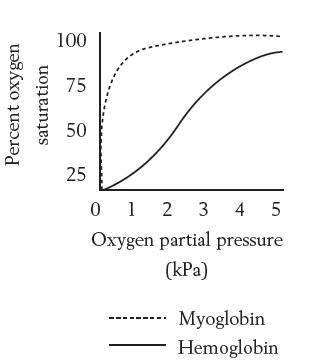
Myoglobin is expressed in muscle cells. The difference between the binding of oxygen to hemoglobin and myoglobin can be best explained by the fact that

A. Hemoglobin must retain oxygen in the veins.
B. Hemoglobin must remove oxygen from oxygen-poor air.
C. Myoglobin must be able to transport oxygen to the brain.
D. Myoglobin must be able to remove oxygen from hemoglobin
E. Hemoglobin must bind oxygen even in the presence of myoglobin

Answer
390k+ views
Hint: Haemoglobin is defined as an oxygen-carrying pigment and predominant protein present in red blood cells. It is an iron containing protein in the blood, which transports oxygen to tissues.
Myoglobin is defined as a red protein containing haem, which carries and stores oxygen in muscle cells. It is an oxygen-binding protein, located primarily in muscle cells.
Complete answer:
Hemoglobin is a tetramer, while myoglobin is a monomeric protein. So, myoglobin can bind to one molecule of oxygen and hemoglobin can bind to four molecules of oxygen. Hemoglobin is present in red blood cells, whereas myoglobin is present in muscle tissue. Both hemoglobin and myoglobin vary in many amino acids in their primary structures.
Option A Hemoglobin must retain oxygen in the veins: In the veins, oxygen is not present as impure blood flows through the veins.
Option A is not correct
Option B Hemoglobin must remove air from oxygen-poor air: When carbon contents are present in the air, hemoglobin drops off the oxygen from it.
Hence, Option B is not correct
Option C Myoglobin must be able to transport oxygen to the brain: Myoglobin serves a local temporary reservoir of oxygen, which can carry oxygen to blood.
So, Option C is not correct
Option D Myoglobin must be able to remove oxygen from hemoglobin: Myoglobin consists of a heme prosthetic group, which can reversibly bind to oxygen. It has more affinity to oxygen from hemoglobin. So it is able to remove oxygen from hemoglobin.
Option D is correct
Option E Hemoglobin must bind oxygen even in the presence of myoglobin: Since myoglobin displaces hemoglobin from oxygen, hemoglobin is not able to bind oxygen in the presence of myoglobin.
Option E is not correct
Option D is the correct answer.
Note:
Haemoglobin is a transport protein. But, myoglobin is an intracellular storage site for oxygen. It binds tighter than hemoglobin due to more affinity The difference in affinity is due to the fact that myoglobin does not have a quaternary structure, as in the case of hemoglobin. The amino acids changes are conservative between two hemoglobin and myoglobin.
Myoglobin is defined as a red protein containing haem, which carries and stores oxygen in muscle cells. It is an oxygen-binding protein, located primarily in muscle cells.
Complete answer:
Hemoglobin is a tetramer, while myoglobin is a monomeric protein. So, myoglobin can bind to one molecule of oxygen and hemoglobin can bind to four molecules of oxygen. Hemoglobin is present in red blood cells, whereas myoglobin is present in muscle tissue. Both hemoglobin and myoglobin vary in many amino acids in their primary structures.
Option A Hemoglobin must retain oxygen in the veins: In the veins, oxygen is not present as impure blood flows through the veins.
Option A is not correct
Option B Hemoglobin must remove air from oxygen-poor air: When carbon contents are present in the air, hemoglobin drops off the oxygen from it.
Hence, Option B is not correct
Option C Myoglobin must be able to transport oxygen to the brain: Myoglobin serves a local temporary reservoir of oxygen, which can carry oxygen to blood.
So, Option C is not correct
Option D Myoglobin must be able to remove oxygen from hemoglobin: Myoglobin consists of a heme prosthetic group, which can reversibly bind to oxygen. It has more affinity to oxygen from hemoglobin. So it is able to remove oxygen from hemoglobin.
Option D is correct
Option E Hemoglobin must bind oxygen even in the presence of myoglobin: Since myoglobin displaces hemoglobin from oxygen, hemoglobin is not able to bind oxygen in the presence of myoglobin.
Option E is not correct
Option D is the correct answer.
Note:
Haemoglobin is a transport protein. But, myoglobin is an intracellular storage site for oxygen. It binds tighter than hemoglobin due to more affinity The difference in affinity is due to the fact that myoglobin does not have a quaternary structure, as in the case of hemoglobin. The amino acids changes are conservative between two hemoglobin and myoglobin.
Recently Updated Pages
Master Class 11 Accountancy: Engaging Questions & Answers for Success

Express the following as a fraction and simplify a class 7 maths CBSE

The length and width of a rectangle are in ratio of class 7 maths CBSE

The ratio of the income to the expenditure of a family class 7 maths CBSE

How do you write 025 million in scientific notatio class 7 maths CBSE

How do you convert 295 meters per second to kilometers class 7 maths CBSE

Trending doubts
10 examples of friction in our daily life

One Metric ton is equal to kg A 10000 B 1000 C 100 class 11 physics CBSE

Difference Between Prokaryotic Cells and Eukaryotic Cells

State and prove Bernoullis theorem class 11 physics CBSE

What organs are located on the left side of your body class 11 biology CBSE

Write down 5 differences between Ntype and Ptype s class 11 physics CBSE




